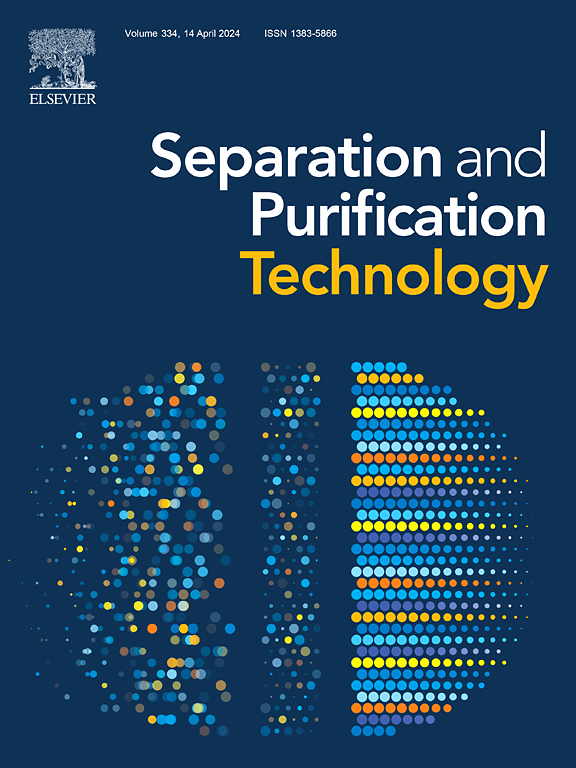Tailoring MXene composition and structure for High-Performance mixed matrix membranes in CO2 separation applications
IF 8.1
1区 工程技术
Q1 ENGINEERING, CHEMICAL
引用次数: 0
Abstract
Incorporating two-dimensional (2D) nanomaterials into polymer matrices can be an effective strategy to increase the performance of membranes, overcoming the permeability/selectivity trade-off. So far, MXene-based gas separation mixed matrix membranes (MMMs) have been limited to Ti3C2 and they demonstrated high gas separation performance. However, information about the influence of composition and structure of MXene on the performance of MMM is still lacking. Herein, a systematic investigation of the effect of the chemical composition and number of layers of MXenes on the CO2 transport properties of MMMs is reported. Mo2TiC2, Ti2C and V2C MXenes were incorporated into a Pebax-1657 matrix. The results revealed that the number of MXene layers considerably affects the dispersion of MXenes in the polymer matrix that contain crystalline and amorphous domains, M3C2 MXenes (Mo2TiC2 and Ti3C2) improve membrane separation more than M2C MXenes (Ti2C and V2C). In addition, in the case of M3C2 MXenes (Mo2TiC2 and Ti3C2), composition strongly affect the dispersion of nanosheets in the polymer, as confirmed by X-ray diffraction and mechanical properties analysis. Molecular dynamics (MD) simulation combined with gas permeation models further confirmed the excellent compatibility of MXenes with the polymer chains. Significant improvement in CO2 permeability (up to 70%) and CO2/N2 separation selectivity (up to 137%) was achieved, placing MXene MMMs above the 2008 Robeson upper bound, implying defect-free interfaces and excellent matrix dispersion. Finally, the impact of feed composition, temperature, and pressure on gas separation performance of the MMMs was fully investigated. Our findings indicate the tremendous potential that tuning MXene properties can have for the development of high-performance gas separation membranes.

裁剪MXene组成和结构的高性能混合基质膜在CO2分离应用
将二维(2D)纳米材料整合到聚合物基质中是提高膜性能的有效策略,可以克服渗透性和选择性之间的权衡。到目前为止,基于mxene的气体分离混合基质膜(MMMs)仅限于Ti3C2,并且表现出了很高的气体分离性能。然而,关于MXene的组成和结构对MMM性能的影响的信息仍然缺乏。本文系统地研究了MXenes的化学组成和层数对MMMs的CO2输运性能的影响。Mo2TiC2, Ti2C和V2C MXenes被纳入Pebax-1657矩阵。结果表明,MXene层数对MXene在含晶态和非晶态结构域的聚合物基体中的分散有显著影响,M3C2 MXenes (Mo2TiC2和Ti3C2)比M2C MXenes (Ti2C和V2C)更能促进膜分离。此外,在M3C2 MXenes (Mo2TiC2和Ti3C2)的情况下,x射线衍射和力学性能分析证实,组成强烈影响纳米片在聚合物中的分散。分子动力学(MD)模拟结合气体渗透模型进一步证实了MXenes与聚合物链的良好相容性。MXene MMMs的CO2渗透率(高达70%)和CO2/N2分离选择性(高达137%)显著提高,高于2008年Robeson上限,意味着无缺陷界面和优异的基质分散。最后,研究了进料组成、温度和压力对mmmm气体分离性能的影响。我们的研究结果表明,调整MXene的性质对于开发高性能气体分离膜具有巨大的潜力。
本文章由计算机程序翻译,如有差异,请以英文原文为准。
求助全文
约1分钟内获得全文
求助全文
来源期刊

Separation and Purification Technology
工程技术-工程:化工
CiteScore
14.00
自引率
12.80%
发文量
2347
审稿时长
43 days
期刊介绍:
Separation and Purification Technology is a premier journal committed to sharing innovative methods for separation and purification in chemical and environmental engineering, encompassing both homogeneous solutions and heterogeneous mixtures. Our scope includes the separation and/or purification of liquids, vapors, and gases, as well as carbon capture and separation techniques. However, it's important to note that methods solely intended for analytical purposes are not within the scope of the journal. Additionally, disciplines such as soil science, polymer science, and metallurgy fall outside the purview of Separation and Purification Technology. Join us in advancing the field of separation and purification methods for sustainable solutions in chemical and environmental engineering.
 求助内容:
求助内容: 应助结果提醒方式:
应助结果提醒方式:


